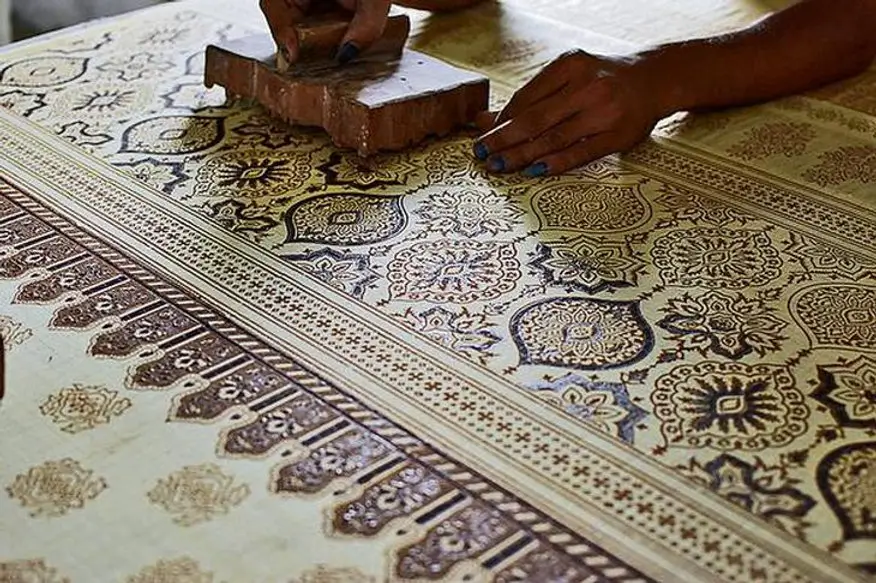Hand Block Printing: Origin, Style & Technique of a Timeless Craft
In an age of fast fashion and digital design, hand block printing stands as a beautiful reminder of humanity’s creativity, patience, and connection to nature. This centuries-old art form transforms plain fabrics into intricate works of art using carved wooden blocks, natural dyes, and skilled hands.
Let’s explore the origin, style variations, and the step-by-step technique that defines hand block printing — especially in textiles like bed linen, garments, and home décor.
📜 Origin of Hand Block Printing
Hand block printing is believed to have originated over 2,000 years ago in China, but it truly flourished and evolved in India, where it became both a craft and a cultural tradition.
India: The Heart of Hand Block Printing
India’s western states — particularly Rajasthan and Gujarat — became global centers for hand block printed textiles. Regions like Bagru, Sanganer, and Ajrakhpur are renowned for distinct printing styles developed over generations. These communities have passed down techniques through family lines, often keeping the skills and patterns within artisan guilds.
🎨 Styles of Hand Block Printing
Each region in India brings a unique identity to hand block printing. Here are some iconic styles:
1. Bagru Print (Rajasthan)
- Earthy tones from natural dyes like indigo and turmeric
- Motifs include vines, flowers, and geometric patterns
- Uses mud resist printing (Dabu) technique
2. Sanganeri Print (Rajasthan)
- Fine floral patterns and delicate motifs
- Often printed on white or light-colored backgrounds
- Known for its intricate detailing and vibrant hues
3. Ajrakh Print (Gujarat and Sindh)
- Ancient, geometric, symmetrical patterns
- Natural dyes like indigo and madder
- Repeated dye-resist process — takes days to complete
4. Kalamkari (Andhra Pradesh)
- Though often done with a pen (kalam), some variations use blocks
- Mythological and narrative storytelling through art
- Typically seen in temple textiles and wall hangings
🖐️ The Technique: How Hand Block Printing is Done
Hand block printing is a meditative, multi-step process — slow, deliberate, and incredibly rewarding.
Step 1: Design Carving
- Designs are carved onto teak wood blocks by master artisans.
- Each color in the design requires a separate block.
- Blocks are treated and seasoned before use.
Step 2: Fabric Preparation
- The fabric (cotton, silk, linen, etc.) is scoured to remove starch and impurities.
- It’s then sun-dried, ironed, and stretched across a long printing table.
Step 3: Color Mixing
- Dyes are mixed in small batches — often natural dyes like indigo, pomegranate, and iron rust.
- Colors are kept in trays with a felt base to absorb excess liquid.
Step 4: Printing
- The block is dipped into dye and pressed firmly onto the fabric.
- Each impression is made by hand — aligned and stamped one by one.
- For multi-color designs, the artisan repeats the process with different blocks.
Step 5: Fixing & Finishing
- The fabric is dried and washed to fix the colors.
- Some pieces are steamed, boiled, or treated with mordants.
- Finally, the fabric is ironed and ready for use in bed linens, clothing, or upholstery.
🌿 The Soul of Sustainability
Hand block printing is not just art — it’s eco-friendly and sustainable. Many artisans use:
- Natural, biodegradable dyes
- Organic fabrics like cotton and linen
- Minimal machinery, reducing carbon footprint
Supporting hand block printed textiles means supporting artisan livelihoods and heritage crafts.
✨ Conclusion: Living Art in Every Thread
From royal courts to modern homes, hand block printing continues to charm the world with its elegance and authenticity. It’s more than a design — it’s a living legacy, telling stories of tradition, identity, and skilled labor. Whether it’s a bedsheet, curtain, or garment, when you choose hand block print, you’re bringing home centuries of art in a single piece of cloth.





